In page 25 of the AD&D 1e Players Handbook, beneath the “FIGHTERS’, PALADINS’, & RANGERS’ ATTACKS PER MELEE ROUND TABLE”, you have this special note for a Fighter:
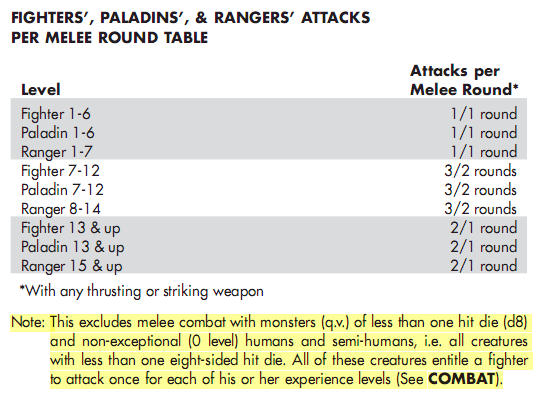
The origin of this particular rule comes from The Strategic Review, Volume 1, No 2, Page 3, in a section called “QUESTIONS MOST FREQUENTLY ASKED ABOUT DUNGEONS & DRAGONS RULES”:


To digest these passages, we have to first understand what a “Hero” and a “Superhero” is that’s being referred to by the text.
To do that, we go back to Original Dungeons & Dragons’s Book I – Men & Magic. In page 16, there are the tables for a Fighting-Man’s levels, Experience points required per level, and level titles:
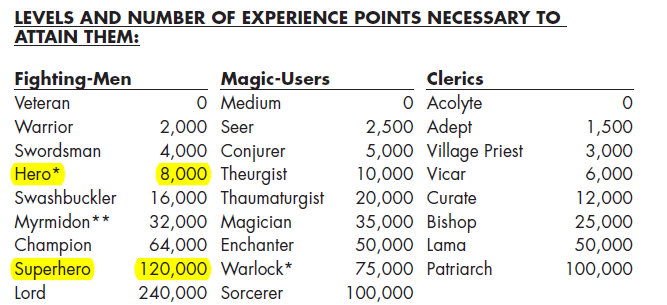
This is further corroborated by looking at Chainmail. In the “3rd Edition” copy that I have, page 30, in the back half that’s the “Fantasy Supplement” of the book, a “Hero” is defined as such:

So in the translation from Chainmail to Dungeons & Dragons via The Strategic Review, the definition of “They have the fighting ability of four figures” would seem to have turned into “they attack four times (per round)”, while Superhero then gets to attack eight times per round because eight is “twice as powerful” as four.
Of course, this only applies to enemies with a base 1 hit die or less as defined in The Strategic Review/OD&D, or to enemies with less than 1 hit die as defined in AD&D.
AD&D also tinkered with the scaling so that the Fighter gets 1 extra attack per level against eligible targets, rather than the sudden jumps from 1 to 4 to 8 with nothing in-between.
But what does the size of Hit Dice mean in in-universe terms? To answer that question, we turn to the following tables, first from page 17 of OD&D Book I – Men & Magic:

A level 1 Fighting-Man player-character is, at the start of the game, already a “Man + 1”. If you were using the Chainmail rules to play miniatures level battles, that has a very specific meaning, basically that when you roll your 2d6 to resolve combat, you’d add a 1 to the result, but in D&D we can simply take it to mean that a PC is, right off the bat, not a rank-and-file footsoldier. Even their own Hit Dice mean that they’re not included in the Fighting-Man’s extra attacks (but a Cleric and a Magic-User might be!)
In the AD&D Dungeon Masters Guide, page 75, we have further corroboration:
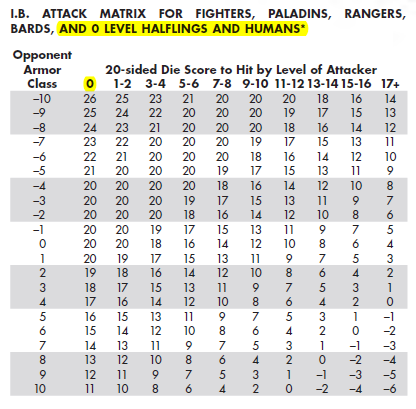
Someone with less than one-whole Hit Die is a “level 0” person/creature.
All of this drives home the historical context that, at least at the outset, Chainmail was supposed to exist side-by-side with Dungeons & Dragons, with D&D “zooming in” to individual combats with larger-than-life figures (i.e., heroes!). A high-level Fighting Man would therefore be able to use their multiple attacks against the “Normal Men” that would compose a unit of, say, pikemen or archers that would otherwise be represented as a set of miniatures on a fantasy wargaming board.
But the thing is, we all know by now that Dungeons & Dragons eventually split off into its own thing, both in terms of as a game that you play by itself with zero interaction with Chainmail, and also in terms of an in-game universe. Where would the multiple attacks come into play then?
The answer lies in the by-the-book monster generation rules. Let’s take a look at page 3 of OD&D’s Book II – Monsters & Treasure:
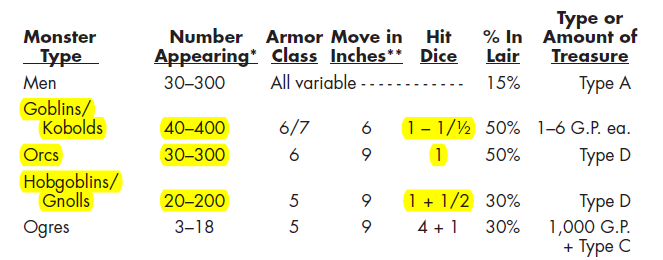
Goblins have a Hit Die of [1-1], or 1 to 5 HP, Kobolds have a Hit Die of [1/2], or 1 to 3 HP, and Orcs have a Hit Die of [1], or 1 to 6 HP, which makes all three of them eligible for a Fighting-Man’s multiple attacks.
Hobgoblins and Gnolls would not be included in a Fighting-Man’s multiple attacks, since they have a Hit Die of [1+1/2] or 2 to 9 HP. Also, an AD&D Orc, which has exactly 1 Hit Die, would not be included in an AD&D Fighter’s multiple attacks, since AD&D’s definition only accounts for creatures with less than 1 HD, whereas OD&D’s definition includes creatures with 1-or-less HD.
And, by God, you’re going to need those extra attacks, because rolling [4d10 x 10] for the number of Goblins means that you’re going to face at least a hundred goblins 98.74% of the time.
The next thing I’d like to mention that’s going to be relevant is the concept of hierarchy and organization within these large groups of monsters. From page 7 of Book II’s specific description of Goblins:

So the Dungeon Master might roll up a hundred goblins, and then within that large group, there’s a “leader” that has just enough HP to be exempt from the “anti-Normal Man” extra attacks. This is a pattern that’s going to repeat over and over: Hobgoblins with a leader that has an Ogre’s stats, Gnolls with a leader that has a Troll’s stats (“but lack regenerative power”), Orcs with even more elaborate rules on tribal leadership, and of course “Men”:

And this idea of large monster groups with a higher-level leader is something that gets carried forward across multiple editions:

This example from AD&D 1e Monster Manual is kind of a perfect fit to the additional attacks mechanic, because the leader and the four assistants are defined as being equal to orcs and having “a full hit die”, which means they’re specifically exempted from the Fighter’s additional attacks, since AD&D Orcs have 1 full Hit Die, and the AD&D Fighter’s extra additional attacks only applies to targets with less than a full HD. So you have that scenario where a high-level Fighter gets to smash multiple goblins per combat round, but then the leader is exceptional and the Fighter has to fight them man+1-to-man+1, as it were.
To be clear, I’m not suggesting that the Fighter’s additional attacks was created because of the hierarchical/organizational aspects of large numbers of humanoids (or vice-versa) – it’s extremely likely that Gygax wrote these creatures this way as a sop to realism, but the two mechanics end up interacting well regardless.
As we move into AD&D 2nd Edition, these additional attacks are relegated to a small optional rule in page 80 of the Dungeon Masters Guide:

Although in this case “Warrior” means including Paladins and Rangers, rather than just specifically Fighters as in previous editions.
And accordingly, the Monster Manual still retains the hordes of “smaller than 1 HD” monsters, and an organization that allows for leaders that are larger than their minions:

Although you’ll notice that per the DMG’s definition, even the “leaders and bodyguards” in this case are still going to be eligible for multiple attacks, since their HD is still [1-1]. The kobolds don’t earn their exemption until the “chief and 2-8 guards” types with [1+1] HD.
In D&D 3rd Edition, most of a Fighter’s explicit abilities got turned into feats instead, which the Fighter was then supposed to spend their bonus combat feats on. While there is no feat that completely duplicates the multiple-attacks rule, the Cleave-to-Great-Cleave feat chain comes somewhat close:
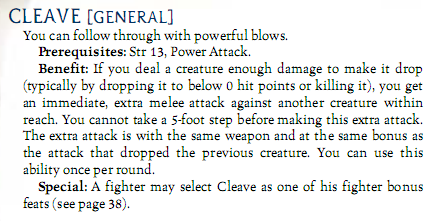

A 3rd Edition Kobold only has 4 HP, and the Goblin only has 5 HP, so it’s perfectly possible to build a character that can deal a minimum of 4 or 5 damage on a single successful hit, which drops a Kobold/Goblin to zero HP, which triggers the Cleave ability, and then they get to attack again.
The key difference is that this sequence of attacks immediately comes to a halt as soon as the character misses once, whereas the AD&D Fighter gets to swing as many times as they have character levels. But in return, Great Cleave isn’t limited by character levels, so a level 4 Fighter could theoretically make eight attacks already if the positioning works out like it should. There’s also a certain symmetry in Great Cleave coming online at level 4, as a throwback to the 4th level Hero of OD&D.
And with regards to positioning, there is also even an Extraordinary Ability called Supreme Cleave that helps with that:

The Knight Protector and the Frenzied Berserker prestige classes, from the Complete Warrior book, both have this ability, as does the Knight Protector and the Master Samurai prestige classes from the Sword and Fist 3.0 book.
Monsters with organization and hierarchy continue to make their appearance in 3rd Edition:
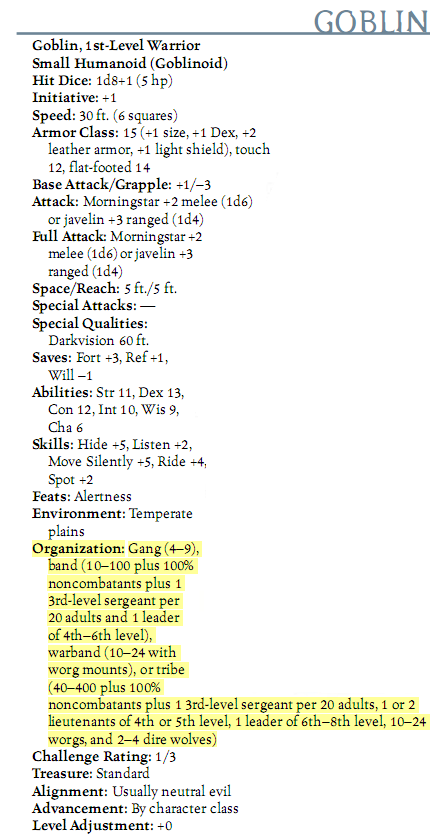
In this case, the edition even gets to show off its “class modularity” feature by simply defining higher-level leaders as having more levels, which the DM can then apply class levels against, whether that’s a Fighter sergeant, a Wizard leader, vice-versa, or even all sorts of different classes, such as a band of Goblins lead by a Bard. The flexibility comes at a trade-off of increased complexity, as the DM would have to create statblocks for these higher-level leaders themselves.
In D&D 4th Edition, there really isn’t anything like the multiple-attacks rule anymore, and even Cleave is “just” a Fighter power that lets the Fighter hit a second adjacent enemy, but the concept of a “Minion” monster is introduced as enemies that explicitly will die upon taking just a single point of damage, making them great targets for abilities that hit multiple targets at once.
This edition also changes the way organizations and hierarchies are presented. Whereas before they tried to deal with the in-universe implications of a literal tribe of humanoids, 4th Edition used the concept of “encounter groups”, or a pre-selected mix of different monsters in different roles to generate a cohesive unit :

The other innovation in this case also being that the Monster Manual would define the statblock for a “ranged goblin” as being separate and distinct from a “melee goblin” and a “spellcaster goblin” in the first place, rather than leaving it up to the DM to fill out just what it meant to have a slightly-higher-level leader and what abilities that that leader should have.
And now, we come to D&D 5th Edition. In this incarnation of the game, cleaving is an optional rule presented in the Dungeon Masters Guide: if a player’s attack reduces an undamaged creature to zero HP, any damage in excess of what was required to reduce the target to zero HP can be applied to any other creature within reach, provided that the original attack roll is still high enough to hit that other target. This spill-over damage can continue to be applied across multiple targets, as long as they are all within reach and the targets keep getting reduced to zero HP.
The rule is even called out as being appropriate if the players get to “regularly fight hordes of lower-level monsters”.
With regards to monster hierarchy and organization, there is still a passing reference to it in the Monster Manual, but the descriptions provided are quite vague – there are no longer specific numbers on the size of a goblin or kobold or orcish tribe, and there’s little guidance on what the stats of a “goblin king” would be beyond “probably should be stronger than the ‘goblin boss’ included in the Monster Manual”.
Perhaps the biggest benefit brought by the latest edition in the vein of this discussion is the role of Bounded Accuracy in keeping even lower-level monsters potentially dangerous. A kobold rolling [d20+4] on their attack still has a 35% chance to hit a plate-armored player-character with 18 AC. To put this in perspective, an OD&D kobold has a 25% chance to hit a Fighting-Man with 3 AC plate armor, and an AD&D kobold has a 15% chance to hit a Fighter with 3 AC plate armor.
As a final thought, exploring the lineage behind this rule brings to mind the possibility of combat whose challenge doesn’t necessarily revolve around having monsters of roughly-equal strength and numbers – of an enemy whose quantity is a quality all its own, and where a numerically superior forces compels the players to approach their respective quests and missions in a more oblique fashion. This is an idea that I hope to delve into further moving forward.
See also the rules in Empire of the Petal Throne, which has a table giving higher-leverl PCs extra damage (not extra attacks) against enemies with fewer hit dice. The implication is that the extra damage allows you to cleave through multiples of the enemy. Thirteenth Age combines the “spillover damage” rule with the 4E minion concept to create “mooks”, which are a threat in combat, but which you can plow through en masse. They function like low-level monsters in 70s-era gaming. —Jonathan Tweet
LikeLike
When designing ACKS, I went through all of these systems (save 5E, unpublished at that time), plus one system you didn’t mention – Dave Arneson’s “chop while you drop” rule, which allowed for fighters to continue attacking as long as they were dropping foes. I discovered Arneson’s rule on the Dragonsfoot Forums. We playtested all these systems, and kept coming back to the chop-while-you-drop rule, combined with a level-based damage bonus, as the best choice for the game. We found the “one attack per level against 1HD or less” rule very frustrating in play because of the sharp differential it created between 1-1 HD and 1 HD monsters. A 14th level fighter was a god against kobolds…and no better than a low-level fighter against orcs.
LikeLiked by 1 person
Very nice writeup. It’s interesting that you highlight 2nd edition allowing attack-per-level to “warriors” and not just “fighters.” When I played AD&D, we assumed that “fighter” included Paladins and Rangers since they are Fighter sub-classes. They received the multiple attacks just like fighters did in our games. It never occurred to me that it was intended as a note that affected only one of the three classes on the table. I’m still not sure what the original intent was.
LikeLike
In AD&D the extra attacks were for Fighters, Paladins and Rangers. It’s not an assumption on your part, it’s literally in the title of the table on pg 25 of the PHB.
LikeLike
[…] of the Blade has done wildly better research than I have done, so instead of recapitulating it, I’mma just link it. This article spans Chainmail through 5e. Do read the comments on this one. Thanks to Tim Baker […]
LikeLike
[…] have had an entirely different connotation. While it’s possible to dive into the old guide, take a random rules element, and then trace both its origins and ultimate evolutions, I also find it enjoyable to go back and read Gygax’s prose just to get a feel for the kind […]
LikeLike
[…] have had an entirely different connotation. While it’s possible to dive into the old guide, take a random rules element, and then trace both its origins and ultimate evolutions, I also find it enjoyable to go back and read Gygax’s prose just to get a feel for the kind […]
LikeLike
“Hobgoblins and Gnolls would not be included in a Fighting-Man’s multiple attacks, since they have a Hit Die of [1+1/2] or 2 to 9 HP. Also, an AD&D Orc, which has exactly 1 Hit Die, would not be included in an AD&D Fighter’s multiple attacks, since AD&D’s definition only accounts for creatures with less than 1 HD, whereas OD&D’s definition includes creatures with 1-or-less HD.”
IIRC, in OD&D a “hit die” was a d6, while in AD&D a “hit die” was a d8, so this apparent change in target eligibility was perhaps to accomodate that?
LikeLike
Reblogged this on Kingmaker.
LikeLike
My interpretation of the HD for hobgoblins and gnolls from the table on page 3 of supplement 2 is a little different than presented in the article: They don’t both get 1 + a half hit dice or 2-9 hit points. It’s 1+1 HD (hobgoblins) / 2 HD (gnolls). So hobgoblins have 2-7 hit points and gnolls 2-12.
This is consistent with the same notation for goblins (1-1 HD) and kobolds (1/2 HD) earlier on the same table, and the hit dice of hobgoblins and gnolls in B/X, BECMI, and AD&D.
LikeLike